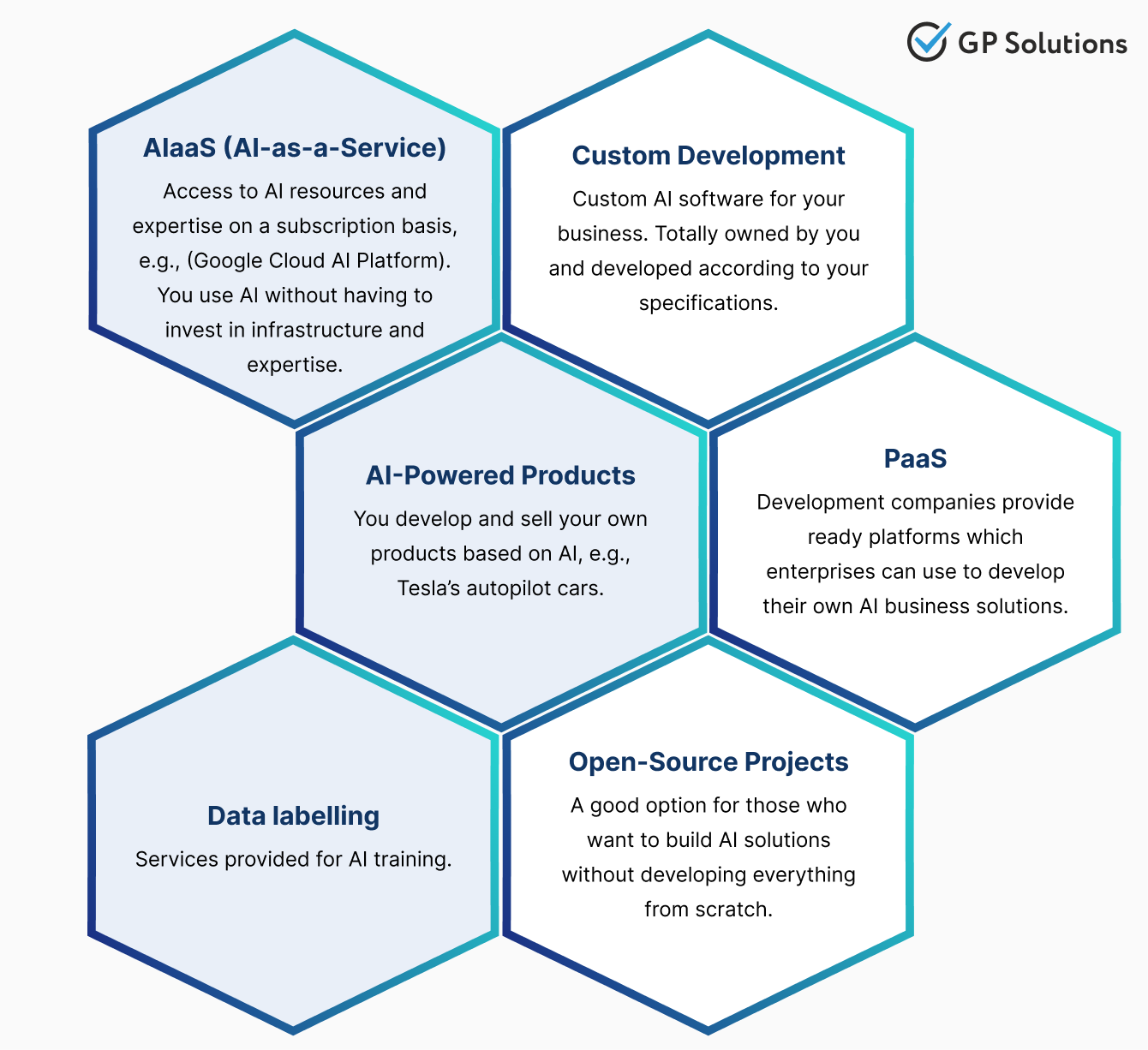The media hype around AI often outpaced the technology’s actual capabilities. However, these days the landscape has changed, and the world is witnessing a true gold rush for AI talents supported by research investments from global players and tech developments. In the USA alone, AI job listings have risen 42% compared to the low point of December 2022 when ChatGPT was released.
In this article, we are going to break down the main reasons enterprises are so welcoming AI technology for business, backed by real-life examples. Also, we will shed some light on the path to the successful implementation of your own AI business model.
What Is an AI Business Model?
To avoid any confusion, let us clarify the difference between two seemingly similar notions — AI model vs. AI business model.
AI Model
As defined by IBM, an AI model is “a program that has been trained on a set of data to recognize certain patterns or make certain decisions without further human intervention”. AI experts provide all sorts of classification for AI models depending on techniques and approaches. The results sometimes overlap or are inconsistent. We offer you a somewhat simplified overview of major ones so you could get the idea what’s best for you.


Not sure which type of AI will do the best job for you? How about a call with our AI tech expert?
AI Business Model
An AI business model is a strategy used by the enterprise to employ artificial intelligence (or any of the above AI models) for its business goals.

Why Do You Need AI Models for Business?
The latest report by McKinsey & Co. clearly highlights a drastic surge over the last 5 years, with 72% of respondents adopting AI in at least one function and generative AI driven business models at the forefront.
Source: McKinsey & Company
The technology transforms not only products or everyday routine but your business model and brings along countless benefits.
Business optimization
Thanks to its immense computing powers, AI will analyze your big data, processes, and input channels way faster than you used to. It’ll help you detect patterns in customer behavior or weak spots in the workflow or draw hidden insights. All these will lead to improved monitoring, better quality, faster business cycles, and, of course, more money in less time.
Enhancing digital experience for your customers
Streaming services, social media, booking platforms, and e-commerce websites are more than happy to embrace AI recommendation engines to provide their users with personalized offers (services, content, or products) in real time.

Capitalization on data tsunami
Enterprises will be driving the global datasphere growth with zettabytes of information added every month. All these structured, unstructured, and semistructured data will be waiting for you to process and draw business insights. The scope and dynamism is so intense that your human workers will hardly manage it on their own without AI-driven business models.
From automation to augmentation
The competitive edge of AI is that it does not merely automate tasks performed by human labor but develops new smarter and faster ways to do them and adjust workflows on the fly depending on the circumstances. Hence, you get enhanced talent management and optimized resource allocation.
Predictive powers
For manufacturers, AI produces equipment failure forecasts, optimizes maintenance plans, and reduces downtime. For those in sales and marketing, it enhances conversion rates through personalization and tailored content. If you are in finances, predictions works perfectly well for fraud detection, investment portfolio management, or risk assessment. In any way, you get all the chances to make informed and, most importantly, timely decisions.
Your personal growth driver
Thanks to strong analytical skills of AI-based business models, you will be able to identify potential revenue streams, extract value from the marketplace, find trends, or even test design and content ideas.
Where and How to Apply AI?
AI can proliferate anywhere when applied wisely. As a sampling of AI adoption below shows, it flourishes in many business functions and across lines of business that were out of reach for neural networks a decade ago.

- Healthcare. Medical image analysis, disease diagnosis, drug discovery, remote patient monitoring, robot assisted surgery, clinical trials, administrative workflow assistants.
- Logistics, transportation. Autonomous vehicles (taxis, trucks, spacecraft), supply chain optimization, stock monitoring, traffic management.
- Entertainment, media, art. Virtual assistants (Siri, Alexa), game AI, image/text/video generation, recommendation engines.
- Security systems. Facial recognition, voice recognition, fraud detection.
- Finances. Fraud detection, risk assessment, algorithmic trading, credit scoring, financial planning, 24/7 customer service (chatbots), investment strategies.
- Education. Tailored training and content, grading automation, virtual mentors and teachers.
- Manufacturing. Process automation, robot control, defect identification, digital twins, quality control, maintenance prediction and scheduling, collaborative robots.
- E-commerce, retail. Personalized product descriptions (area, language, personal preferences), dynamic pricing, product demand predictions.
In our recent article, we made a deep analysis of AI in the travel industry. Feel free to check the latest developments for travel companies.
Big-Name Companies that Embraced AI and Beat the Competition
Enough theory for now. We suggest having a bit of reading about real-life examples of successful AI business models implemented by loud names.
- Personalized content recommendations
- Automatically generated thumbnails
- Streaming quality (predicting viewer patterns and network traffic congestion → caching regional servers to optimize loading times)
- Content quality checks
- AI-powered chatbot: bookings, help desk, available under high load
Multilingual support - Flight scheduling based on crew availability and locations, passenger demand, aircraft maintenance status, weather, etc.
- Automated driving technology
- Improved safety systems
- AI in design processes → more efficient and innovative cars
- Predictive analytics for user behavior and driving habits
- Choosing manufacturing materials
- Production line assistance
- Machinery troubleshooting
- In-store voice assistants for retail stuff
- Customer-centric insights (purchasing behavior, browsing history, engagement patterns)
- Dynamic recommendations and adaptive content
- Real-time engagement in response to triggers (abandoned carts, new product launches)
Implementation Roadmap. How to Proceed?
If you set your mind on embedding AI to your business, building a solid strategy to implement your AI based business model is inescapable before you set sails. Plan and think through every step to follow. Yet bear in mind that AI adoption is not a perfect science, and your initial ideas may be flawed, so be ready for experiments and adjustments on the way.
As a way of template, we have elaborated a plan you can stick to or integrate into your own vision.
Identify business needs
Each business has its own reason to adopt AI and its own definition of the mission’s success. Some use it to optimize supply chain forecasting, while others aim to boost customer engagement and increase sales. The tricky point here is to set your own priorities aligned with your own business strategic goals. Also remember that although AI is basically limitless in what it can do, do not try to apply it everywhere all at once. Start small and then go big.
Select the right AI business model
Findings from the IBM Global AI Adoption Index 2023 indicate primary concerns hindering the adoption of AI-driven business models are “limited AI skills, expertise, or knowledge” alongside with “too much data complexity”, projects that “are too complex or difficult to integrate and scale”, and “a lack of tools/platforms for developing AI models”. The reasons are mostly of technical nature, that is why many enterprises opt to fill in these gaps with outsourcing AI services if their in-house team clearly have no capacity to deal with the task.
In the first chapter of this article, we’ve already described which models exist and which tasks they perform. This time we just wanted to stress the importance of your choice as it can considerably hamper the success of the entire project. If your data meet an inadequate AI business model during training, the consequences will be very detrimental.
Prepare your data for the job
Data must come from authoritative sources with clearly defined access rights. Do not forget that historical data is not enough, as you must continuously update and distribute information. So set respective pipelines and assign people to do the task. A legal aspect is a must, so establish sound governance, cybersecurity, compliance, and privacy practices.
Practical note: do not feed your AI business model with every piece of information available on your servers. Assess its value and send only those bits that are relevant.
Train and develop your model
Pay attention that it’s not enough to simply introduce artificial intelligence into your software system. Train it first with your data and according to algorithms that are relevant and customized to your goal.
Integrate your AI solution into the existing system
Assess your capabilities, both in terms of software/hardware and human resources. Your AI business model may be the smartest and the most efficient out there, but it won’t fit the purpose unless you preliminarily take care of your tech foundations (tech architecture and enterprise data models). New hardware and software will be a good idea if it’s been a while since your last upgrade.
Through education and on-site training, you will close the gap in technical skills. At the same time, your AI vendor may contribute to on-the-job training.
Pilot testing
At this stage, you will need to check the accuracy and reliability of your AI solution in real-world scenarios. Ideally, a well-trained team of AI developers, data scientists, and business process experts will have to test AI algorithms in a scientifically controlled environment and validate results.
Deployment
Now is the time to say final goodbye to old-fashioned processes. A good option would be to resort to cloud deployment since AI can do more with data when it’s in the cloud.
Teach your employees how to reinvent their mode of work with AI — automate mundane tasks and amplify creativity or performance.
Monitoring and maintenance
You are never done with an AI project as neural networks evolve as we speak. Assign a task to your business teams to be on the lookout for new opportunities to improve AI business models and processes. Monitor feedback from any party involved — customers, partners, and your own employees.
What’s the Catch?
As you embrace AI technologies, tread with some caution, as it may entail certain risks. However, with proper QA protocols and procedures in place, artificial intelligence will bring nothing but lightning-speed insights, accurate results, and elevated customer satisfaction.
- Bias. AI is driven by data and heavily relies on its quality for training. Faulty raw data and biased information may lead to errors or even socially unacceptable responses. The answer to that is simple: feed your AI with quality.
- Ethics and accountability. AI can be misused to create inappropriate or false information. Who will be taken to court if something goes terribly wrong? How to proceed in case of a political deepfake making world headlines? However, with time and the technology’s integration into our society, we are surely to see the implementation of ethical laws to control its deployment.
- Security. Powerful algorithms can learn a lot about your enterprise by drawing insights from massive data you generate. They will even know more than the company’s owner itself. May a hacker attack happen or access codes get into the wrong hands or leak to the public or at least your competitors, the scale of consequences will be immeasurable. That is why proper security measures and protocols must be your top priority.
- Possible lay-offs. For now, it is too soon to say anything about the impact on the overall employment. Yet, for instance, a lot of concern has been raised lately by unions of creative professionals at Hollywood studios who fear AI can take up the job of screenwriters, animators, and shooting teams. Our view here is that AI will only strengthen those workers who are genuine at their core and save up their time to take more creative risks.
- AI hallucinations. That is more of an issue for generative AI solutions, as they occasionally may provide inaccurate results. Still, with quality control procedures in place, that issue can be mitigated.
Risks cannot be avoided, but can be managed. There is one simple solution to them — human-AI teaming: do not let your AI business model roam free without human supervision. Use AI to augment human intelligence, not to replace human workers entirely, and your enterprise will be in safe hands.
Trends and Predictions. What’s Next?
AI is designed to generate profits. Recent studies by MarketsandMarkets forecast that the AI market globally will cross over 1,345 billion by 2023 from around 200 billion of 2024 (at a CAGR of 36.8%). All thanks to deep interactions with various other techs and manifestations in all possible domains.

Let us focus on the predictions that are already becoming trends.
- ChatGPT and other generative AI models everywhere. The need for generative AI solutions in such sectors as media, entertainment, marketing, and healthcare will be the driving factor behind the expansion of the generative AI market. GPT-4o released on May 13, 2024 is a vivid example of how fast generative AI is evolving. “OpenAI is the most advanced and most widely used platform in the world now,” noted Sam Atman, one of OpenAI’s co-founders. The success of generative AI models lies in there accessibility to larger audiences, as they can be used both by a ten-year-old schoolboy and his 65-year-old grandpa.
- Explainable AI. The idea here is to make AI understandable by common people and increase trust in the technology. A certain breakthrough was made here thanks to generative AI and its most renowned impersonation ChatGPT. Thanks to the methods and processes it uses, humans will understand AI decision-making processes, ML algorithms, and the entire logic behind neural networks, which will cultivate trust in AI outputs.
- Edge Computing. The closer AI processing is to data sources such as edge devices, the faster your decision-making will be. The acceleration will also be boosted by the heavy reliance on cloud-based solutions.
- Quantum computing in business applications leverages the power of quantum mechanics and will have a drastic impact on machine learning. It can process calculations of diversified tasks at the same time and run millions of simulations in parallel. It is a good friend of complex algorithms that are designed for optimization problems. As a result, we will have faster, more powerful, and more accurate AI business models.
- AI chips in high demand. As the AI adoption keeps spreading, normal GPUs will no longer fit the purpose efficiently and be replaced with the so called ‘AI chips’. Thanks to their innovative design, they can process information much faster and will answer the evolving need for myriads of processes running at the same time. The ultimate leader in the field, Nvidia, is looking to upgrade its accelerators each year, not least involving AI to redesign the chip structure.
The race to invest in high-end AI chips

Before You Go
Big data and the ever-increasing computational power turned sci-fi plots of the last century into AI business models that have crossed a threshold of the real world and become part of the industrial landscape. If you are a medium-size business, the right AI model will help you go bigger, while for large-scale enterprises, the AI potential will also lead to enhanced efficiency, new markets, and deeper insights. You can try implementing AI all by yourself, or entrust your worries to a software development company like GP Solutions.
AI may definitely disrupt your business model, but with proper AI strategies for business transformation, you’ll get nothing but results and saved money and make a change in the eyes of your competitors. The limit is your budget and probably awareness of AI capabilities.


















